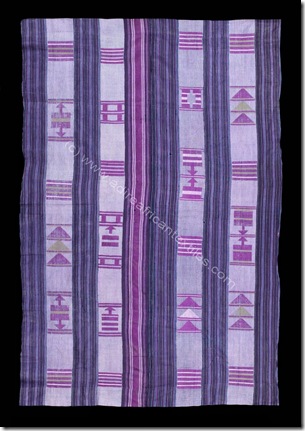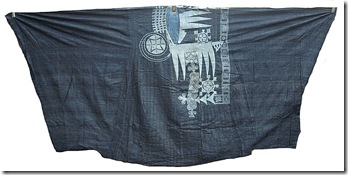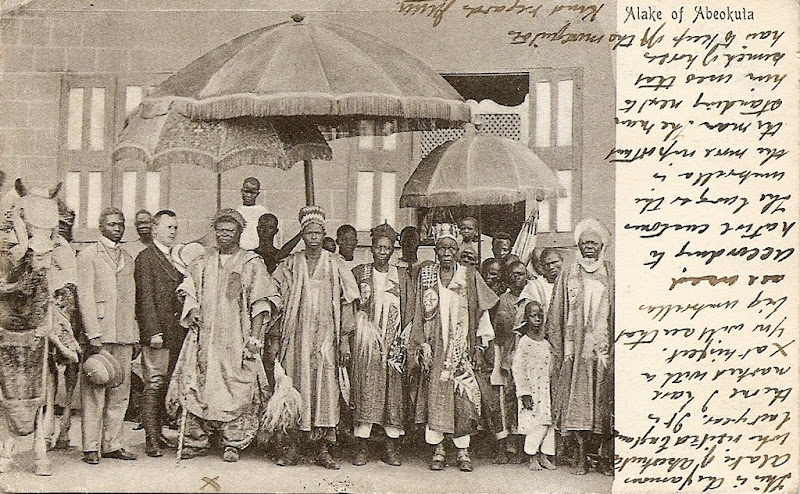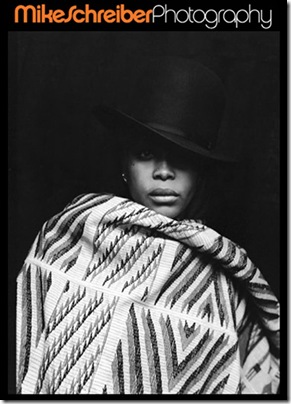The Art And Architecture Of Yorubaland! - Culture (7) - Nairaland
Nairaland Forum / Nairaland / General / Culture / The Art And Architecture Of Yorubaland! (131658 Views)
A Short History Of Yorubaland With Pictures / Art And Architecture Of The Igbo People / Benin Art And Architecture (2) (3) (4)
(1) (2) (3) (4) (5) (6) (7) (8) (9) (10) ... (16) (Reply) (Go Down)
| Re: The Art And Architecture Of Yorubaland! by tpia5: 11:22pm On Oct 11, 2011 |
oba's beaded cushion  |
| Re: The Art And Architecture Of Yorubaland! by tpia5: 11:28pm On Oct 11, 2011 |
an ooni of ife  an oba from igbomina [img]http://2.bp..com/_aUqPfZp3myE/S83vBLJK_GI/AAAAAAAAABA/ruFCQ5-Ssvk/s1600/untitledE.jpg[/img] |
| Re: The Art And Architecture Of Yorubaland! by lakal(m): 2:25am On Oct 12, 2011 |
Yorubas do love many varieties of beads. These are all coronets, dating from the late 19th Century. The beads used are of the glass variety.  |
| Re: The Art And Architecture Of Yorubaland! by lakal(m): 2:27am On Oct 12, 2011 |
Beadwork often has a royal connotation. This is a late 19th Century robe of the Deji of Akure. The materials used are velvet and beads. [img]http://t1.gstatic.com/images?q=tbn:ANd9GcRrsAZfcU929Mq7POXlMtIWS4YINE_8ROgXKB7akUK2GM4AG_Ff[/img] |
| Re: The Art And Architecture Of Yorubaland! by lakal(m): 2:48am On Oct 12, 2011 |
Another Deji of Akure (Oba Ademuwagun Adesida II) in 1959. Note the beaded robe as well as the beaded crown (Ade Ileke).  |
| Re: The Art And Architecture Of Yorubaland! by lakal(m): 2:51am On Oct 12, 2011 |
Artistic depiction of the current Alaafin of Oyo.  |
| Re: The Art And Architecture Of Yorubaland! by lakal(m): 3:02am On Oct 12, 2011 |
(I see tpia touched on this briefly) Interesting notes on the importance of beads to West Africa. This site describes beads found in what is now Ghana that have their origins in Yorubaland, carried there by trade. There is evidence of an extensive glass bead industry dating back several centuries, Source: http://www.beadbabe.com/archives/html/yoruba_glass_beads_by_kwesi_am.html Legend has it that these beads were first made by Olokun, a female deity and member of the Yoruba founding family. The original materials likely came from gravesites in and around Ife, such as the famous Olokun Grove. Later, as the original sources became exhausted, newly imported glass bottles and beads were substituted. "Kori" stones are an intermediate step in the process, but these "stones" were also objects of veneration and worship, known locally as aje ileke and aje Olokun, "wealth of beads" and "wealth of Olokun", respectively. |
| Re: The Art And Architecture Of Yorubaland! by lakal(m): 3:09am On Oct 12, 2011 |
The early explorers to Nigeria had interesting perspectives on the cultural manifestations they observed. Below is a depiction of a Yoruba masquerade, "The Masked Mummers of Yoruba" from Blackie (1912) based on the early 19th Century descriptions of Clapperton and Lander.  |
| Re: The Art And Architecture Of Yorubaland! by lakal(m): 3:52am On Oct 12, 2011 |
The Orangun of Ila, late 19th Century. [img]http://stevenson.info/exhibitions/realities/power/images/item5.jpg[/img] As a direct descendant of one of sixteen children of Odudua, the god, orisha, who added the creation of the world and who was the first king of the Yoruba people, the Orangun is one of the few Yoruba kings privileged to wear the veiled beaded crown. Whether it was orisha Olokun or orisha Obalufon who blessed mankind with the gift of beads, the privilege of their use has traditionally been reserved to kings, to the priests and priestesses of certain gods, and to the herbalist-diviners, that is, to people whose spiritual powers enable them to move across the boundary that separates man from the gods, the secular from the sacred. It is, however, only to the king that the full range of beaded artifacts is permitted: shoes, fans, flywhisks, footrests, canes, ceremonial staffs, thrones, and crowns. See William Fagg, Yoruba Beadwork, Art of Nigeria, Pace Editions, 1980. |
| Re: The Art And Architecture Of Yorubaland! by lakal(m): 3:53am On Oct 12, 2011 |
The Alake of Abeokuta on a visit to London, 1904. Check out the beaded slippers. [img]http://stevenson.info/exhibitions/realities/power/images/item2.jpg[/img] The Alake, president of the council of chiefs, or ruling chief, photographed on his visit to Britain in 1904. The chief was a man of great intelligence, eager to study western civilization, and an ardent agriculturist, and his visit elicited considerable public interest. |
| Re: The Art And Architecture Of Yorubaland! by tpia5: 4:23am On Oct 12, 2011 |
very interesting. this website discusses some forms of yoruba art ( the feathers on the crowns are also referenced here): http://onthehuman.org/2010/02/animalia-the-natural-world-art-and-theory/ the author [an american or european lady i think] feels motifs for ancient yoruba art were heavily influenced by outside interaction with places like egypt, mauritania and nubia, while some of the commentators think yorubas drew their inspiration from nature. |
| Re: The Art And Architecture Of Yorubaland! by tpia5: 4:28am On Oct 12, 2011 |
Ray Silverman has documented a sizable number of large metal Mamluk (Egypt, 14th century) basins at sites near the gold fields in Ghana (where they were integrated into shrines and carefully preserved). In Ife specifically, we have visual references to metal crotals. Textiles, alas, have not survived, but at a site of royal retreat near Ife, silk worms were being harvested into the late 20th century, the silk being woven into ritually important fabrics — suggesting to me that Ife may have been part of the Silk Road perhaps as early as the early fourteenth century, i.e. in the decades after Marco Polo’s return. Textiles at Ife are identified with King Obalufon who ruled in this era. At this same time silk factories were being set up in Italy and France among other places. (The only other place in Africa I know where silk worms were harvested is Madagascar; I think there also was silk production at this time in Egypt.) For books (manuscripts): several Yoruba and other scholars have identified a group of Arabic texts as a partial source for Ifa divination. The authors of these manuscripts are praised by Yoruba diviners and healers today as part of rituals; one of best known of these Muslim authors lived and wrote in the fourteenth century, and his writings are said to show evidence of ties to both Persia and China. http://onthehuman.org/2010/02/animalia-the-natural-world-art-and-theory/ |
| Re: The Art And Architecture Of Yorubaland! by tpia5: 4:40am On Oct 12, 2011 |
I believe that Battuta is describing Ife in his early fourteenth century reference to a kingdom to the west of Mali, notable in part for its extraordinary wealth. Ife in this era seems to have had an international “pulse.” The famous blue-green Ife glass beads were found as far away as Mauritania, Mali, and Ghana. At Ife itself there is evidence of cowries from the Indian Ocean and crotals (an ancient bell form) which have early prototypes in southeast Asia, India, north East Africa (Egypt) and Europe as prestigious decorative items for humans and horses. For other examples of international trade in this broader region one can point to a Nubian work discovered Niger to the north of Ife and Coptic language forms that today are common in the Hausa area. In Ife itself, a stone pendant unearthed by Ekpo Eyo at the royal burial site of Lafogido (along with the famous “royal” animals) bears a Maltese (Coptic) cross, similar to one that also appears on the robe of the standing copper alloy figure from the Niger River crossing site of Tada. |
| Re: The Art And Architecture Of Yorubaland! by tpia5: 4:49am On Oct 12, 2011 |
bears a Maltese (Coptic) cross, similar to one that also appears on the robe of the standing copper alloy figure from the Niger River crossing site of Tada.  the maltese cross in question is on the lower right edge of this statue's robe. the statue itself is dated 14th - 15th century and the tsoede bronzes are linked to ife and owo art. [influenced by]. |
| Re: The Art And Architecture Of Yorubaland! by Booshman(m): 5:52am On Oct 12, 2011 |
I love all of these rare pictures of the royal figures, but why are they always so small? |
| Re: The Art And Architecture Of Yorubaland! by lakal(m): 3:46pm On Oct 12, 2011 |
^^ They don't seem particularly small on my computer. However, I think it may be because I directly link the pictures; I don't upload them from my computer. |
| Re: The Art And Architecture Of Yorubaland! by lakal(m): 2:14am On Oct 13, 2011 |
 Stone statue of the deity Idena (the gatekeeper). Has iron nails in its coiffure and elaborately tied sash, circa 11-12th Century. The objects on his wrapper appear to be keys (making sense since Idena = gatekeeper). |
| Re: The Art And Architecture Of Yorubaland! by tpia5: 2:15am On Oct 13, 2011 |
crown:  this is a greek sculpture (cant find the date) of zeus. Note the crown ( at least that's what i think it is. Could also be hair i suppose):  |
| Re: The Art And Architecture Of Yorubaland! by lakal(m): 2:19am On Oct 13, 2011 |
Edited. |
| Re: The Art And Architecture Of Yorubaland! by tpia5: 2:22am On Oct 13, 2011 |
I'm comparing the crowns. |
| Re: The Art And Architecture Of Yorubaland! by tpia5: 2:23am On Oct 13, 2011 |
lakal: this definitely looks egyptian. starting to wonder if there's a sudanese link at some point. |
| Re: The Art And Architecture Of Yorubaland! by tpia5: 2:46am On Oct 13, 2011 |
11th - 15th century   |
| Re: The Art And Architecture Of Yorubaland! by tpia5: 2:54am On Oct 13, 2011 |
ancient ife quartz stool or bowl: [img]http://hum.lss.wisc.edu/hjdrewal/ife_new_4_jthu.jpg[/img]  greek(date unknown):  |
| Re: The Art And Architecture Of Yorubaland! by tpia5: 3:16am On Oct 13, 2011 |
 12th- 15th century |
| Re: The Art And Architecture Of Yorubaland! by lakal(m): 11:52am On Oct 13, 2011 |
A variety of textiles were woven by Yoruba men and women. [img]http://2.bp..com/_o3RfR0wD8Y8/SrI2VkzXn7I/AAAAAAAAAD8/jHT5yusuuYM/s320/Berlin+yoruba.jpg [/img] This remarkable ifa divination bowl (Yoruba, Nigeria) from the Ethnography Museum, Berlin, depicts a woman weaver on the upright single heddle loom (Photo from Brigitte Menzel, Textilien Aus Westafrika, Museum fur Volkerkunde, 1972) |
| Re: The Art And Architecture Of Yorubaland! by lakal(m): 11:53am On Oct 13, 2011 |
[img]http://1.bp..com/_o3RfR0wD8Y8/SsSrwtUQ13I/AAAAAAAAAFM/xWcscP4Bl6k/s400/nw396.jpg[/img] Nigerian Women's Weaving. Nigerian women used a different type of loom to the man's narrow strip device found throughout West Africa, weaving wider panels of fabric. NW396: Woven by Ijebu Yoruba women in the town of Ijebu-Ode and its surroundings, these extraordinary cloths are used as insignia of office by Ijebu chiefs and members of a society known as Ogboni (which in the past had responsibilities for the worship of the Earth deity and advised the king.) The designs represent various important spirit familiars including frogs, crocodiles etc. This four panel indigo dyed blue and white type, woven from thick hand spun local cotton is very rare. The right hand panel has at some point been cut near the centre and stitched back together, but otherwise condition is excellent. Dates from circa 1900-20. Source: adireafricantextiles..com |
| Re: The Art And Architecture Of Yorubaland! by lakal(m): 11:55am On Oct 13, 2011 |
 This classic style of nineteenth century Yoruba aso oke cloth involved the alternation of a simple warp striped strip with a second design in which supplementary weft float motifs are laid out on a fine blue and white checked background. In an early example such as this the magenta silk thread alaari from the trans-Saharan caravan trade is combined with local hand spun indigo dyed cotton. In some cases, as here, there is one different warp striped design to add variety. Although the supplementary weft float motifs are largely based on the Koranic board shape (a wooden rectangle with an arrow head at the top, used by boys at Islamic schools as a writing board) in early examples as here the weaver plays around with variations on the shape. |
| Re: The Art And Architecture Of Yorubaland! by lakal(m): 11:58am On Oct 13, 2011 |
 Agbada is the Yoruba name for a type of flowing wide sleeved robe, usually decorated with embroidery, which is worn throughout much of Nigeria by important men, such as kings and chiefs, and on ceremonial occasions like weddings and funerals. The Hausa name for the robes is riga. Although today they are often still made from hand-woven cloth, the painstaking and beautiful hand embroidery that was used in the past is very rarely seen. Fine old robes have become family heirlooms passed on from father to son and worn with pride at major celebrations. In the past prestige robes were traded over vast distances and similar or related garments are found throughout much of West Africa. |
| Re: The Art And Architecture Of Yorubaland! by lakal(m): 12:00pm On Oct 13, 2011 |
 Examples of traditional Agbadas in this photo. Vintage postcard, circa 1900, author’s collection. The Alake of Abeokuta was the senior king of the leading town of the Egba Yoruba in south western Nigeria. source:adireafricantextiles..com 1 Like |
| Re: The Art And Architecture Of Yorubaland! by lakal(m): 12:03pm On Oct 13, 2011 |
[img]http://4.bp..com/_o3RfR0wD8Y8/SyeGRu28iBI/AAAAAAAAALk/xTAySuVK3FA/s400/Asooke353.jpg[/img] Superb and rare early C20th woman's wrapper. Each strip combines fine hand spun indigo checked "etu", "guineafowl pattern," with magenta "alaari" - silk from the trans Saharan trade. It would have been an extremely expensive and prestigious cloth in its day. In searching for these early cloths I look for pieces where all the original hand stitching is intact, as here. After almost a century many have begun to come apart at the seems and been restitched using a sewing machine, often in a less than careful way. Intact pieces like this have a pleasing completeness but are extremely rare. Dates from circa 1900-1920 and is in excellent condition. |
| Re: The Art And Architecture Of Yorubaland! by lakal(m): 12:05pm On Oct 13, 2011 |
 From ARISE magazine, issue 11. Erykah Badu wears a vintage Yoruba aso olona cloth. Aso olona (“cloth with designs”) are woven on the upright loom by Yoruba women in the vicinity of the city of Ijebu-ode and were worn as insignia of office by chiefs and officials in the Oshugbo/Ogboni association of Earth priests and priestesses. The style dates back to at least the C18th. Source: adireafricantextiles..com 1 Like |
| Re: The Art And Architecture Of Yorubaland! by tpia5: 6:25pm On Oct 13, 2011 |
^^not familiar with that design but it looks interesting. 1 Like |
(1) (2) (3) (4) (5) (6) (7) (8) (9) (10) ... (16) (Reply)
Traditional Eastern Ijaw Attire In Pictures / Oruko Amutorunwa (generic Names In Yoruba Culture) / 18+ Unclad Photos Of African Women Slaves From The Past.
(Go Up)
| Sections: politics (1) business autos (1) jobs (1) career education (1) romance computers phones travel sports fashion health religion celebs tv-movies music-radio literature webmasters programming techmarket Links: (1) (2) (3) (4) (5) (6) (7) (8) (9) (10) Nairaland - Copyright © 2005 - 2024 Oluwaseun Osewa. All rights reserved. See How To Advertise. 44 |